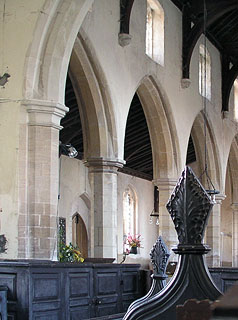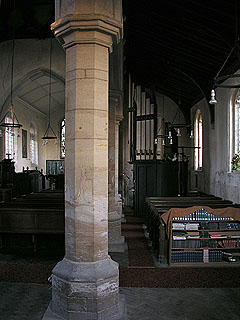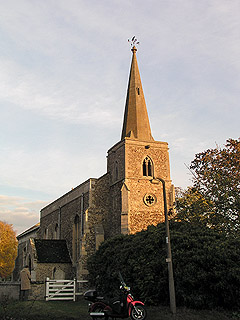We found St Mary locked, so while Mark went off to get the key from across the road, I examined the outside of the building.
St Mary presents a severe aspect to the road - there is no aisle on this side so although the windows are impressively tall it looks rather forbidding.
The tower is very small - the roof of the nave laps up against the bell-stage, making it look almost like an afterthought. This isn't entirely fair, since the tower is very pretty - it has a dainty little spire and a quatrefoil air-hole in the west face, picked out in the nice ivory-coloured local stone. Most of the church is constructed from golden-brown fieldstones.
Mark returned from getting the key. It is kept over the road, and he caught the resident feeding his rabbits. He was quite happy to go off and get the key for us, but apparently the rabbits (of which there were lots and lots) stared at Mark rather interestedly as he waited.
The interior of the nave suggests that the tower isn't quite as small as it seems - this is a remarkably high nave for such a small church.
The south aisle is separated from the nave by a particularly beautiful arcade of tall octagonal piers on neatly moulded plinths.
Above our heads, the roof sat on carved corbels in the form of human heads variously grinning, leering and scowling down at us.
Under the chancel arch (of the same elegant design as the south arcade) are the remains of the rood screen - only the dado survives, looking sad and battered and now built into the Jacobean box stalls that fill the western part of the chancel. The choir stalls further in are also, incidentally, from the early 17th century.
A bit of the screen itself survives and has been mounted on the wall in the south aisle. I thought it looked strangely classical - or at least Renaissance - but perhaps my eyes deceive me; it is only a small patch, after all.
In the chancel, I thought the double piscina and double sedilia (both 13th century) were a nice survival.
More unusually, there is a blocked-up squint in the north wall, leading from the altar out into the churchyard - presumably for administering the sacrament to those considered unclean and therefore forbidden from entering the church itself.
Pevsner, in uncharacteristically coy speculation, writes 'Can it be Saxon?' - I'd like to think that it is, but since the RHCM doesn't cover this area, I'm going to be sceptical. Even if it doesn't bespeak extreme age, it's an interesting relic of old practices. It's just a hole in the wall, really, but (like the poor mutilated screen and the box pews) it breathed life into the building, and summoned the shades of many ages to mutter and kneel in the chilly November light. Even the rabbits looked thoughtful when I dropped the key back with them.
St Mary's is kept locked, but the keyholder is just over the road



